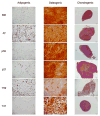Characterization of mesenchymal stem cells from human vocal fold fibroblasts
- PMID: 20131365
- PMCID: PMC2829335
- DOI: 10.1002/lary.20797
Characterization of mesenchymal stem cells from human vocal fold fibroblasts
Abstract
Objectives/hypothesis: Mesenchymal stem cells (MSCs) originally isolated from bone marrow (BM), are fibroblast-looking cells that are now assumed to be present in the stromal component of many tissues. MSCs are characterized by a certain set of criteria, including their growth culture characteristics, a combination of cell surface markers, and the ability to differentiate along multiple mesenchymal tissue lineages. We hypothesized that human vocal fold fibroblasts (hVFF) isolated from the lamina propria meet the criteria established to define MSCs and are functionally similar to MSCs derived from BM and adipose tissue.
Study design: In vitro study.
Methods: hVFF were previously derived from human vocal fold tissues. MSCs were derived from adipose tissue (AT), and BM of healthy donors based on their attachment to culture dishes and their morphology and expanded in culture. Cells were analyzed for standard cell surface markers identified on BM-derived MSCs and the ability to differentiate into cells of mesenchymal lineage (i.e., fat, bone, and cartilage). We investigated the immunophenotype of these cells before and after interferon-gamma (INF-gamma) stimulation.
Results: hVFF displayed cell surface markers and multipotent differentiation capacity characteristic of MSCs. Furthermore, these cells exhibited similar patterns of expression of human leukocyte antigen and costimulatory molecules, after stimulation with INF-gamma compared to MSCs derived from BM and AT.
Conclusions: Based on our findings, hVFF derived from lamina propria have the same cell surface markers, immunophenotypic characteristics, and differentiation potential as BM- and AT-derived MSCs. We propose that vocal fold fibroblasts are MSCs resident in the vocal fold lamina propria.
Conflict of interest statement
Figures




References
-
- Hansen JK, Thibeault SL, Walsh JF, Shu XZ, Prestwich GD. In vivo engineering of the vocal fold extracellular matrix with injectable hyaluronic acid hydrogels: early effects on tissue repair and biomechanics in a rabbit model. Ann Otol Rhinol Laryngol. 2005;114(9):662–670. - PubMed
Publication types
MeSH terms
Substances
Grants and funding
LinkOut - more resources
Full Text Sources
Other Literature Sources

